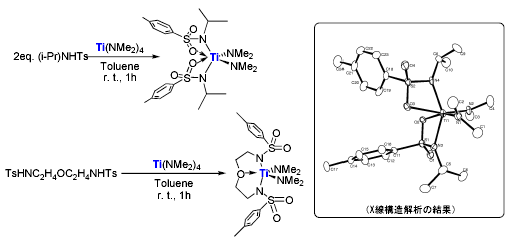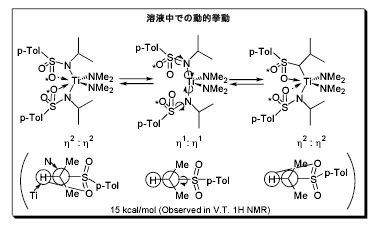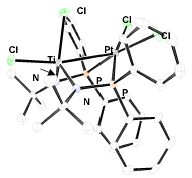Construction of Early-Late Heterobimetallic Complexes (ELHB) and examination of their dynamic behavior.
Design of novel oraganometallic complexes aiming at catalysis

Hapticity changes in conjugated π-ligands are thoroughly investigated phenomena in organometallic chemistry. In particular, the η1- and η3- interconversion of allyl and pseudo-allyl ligands is commonly observed in a wide variety of organotransition metal compounds. We are interested in the synthesis, structure, dynamic behavior, and catalytic properties of transition metal complexes with pseudo-allyl ligands containing heteroatom(s).
For instance, we have reported the synthesis of highly air- and moisture-sensitive titanium complexes with sulfonamide ligands and their catalytic activity toward ethylene polymerization. Solution dynamics revealed the hapticity of the ligand changes.


Construction of ELHB complexes using phosphinoamide as a bridging ligand
Next, we synthesized novel transition metal complexes with phosphinoamide ligands. Phosphinoamide ligands should have the ability to change the hapticity, which will allow Early Late Heterobimetallic (ELHB) complexes with metal-metal cooperative interactions to be constructed.

Treating lithium phosphinoamide with TiCl4 affords titanium phosphinoamide in a good yield. As expected, variable temperature NMR studies suggest that in solution the phosphorous moieties can reversibly dissociate from the titanium. The dissociated phosphorous moieties are effectively captured by Pt(II) species such as (COD)PtCl2 to afford the corresponding Ti-Pt heterobimetallic complexes.


The molecular structures of these complexes reveal that they are six-membered dimetallacycles in the boat form where a titanium molecule and a platinum molecule are connected by two bridging phosphinoamide ligands. The Pt-Ti distance indicates a Pt→Ti dative bond. In addition, this intramolecular interaction between titanium and platinum depends on the substituents on the platinum atom. These results offer unique and general access to a novel class of ELHB complexes, which may exhibit interesting behaviors in organometallic reactions and catalysis. Further investigations using these types of phosphinoamide complexes such as the metalloligand are currently in progress.

